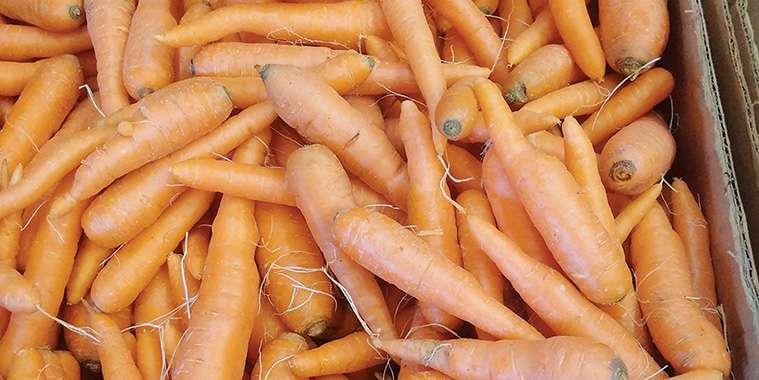By Dorothy Dobbie
Long before designer vegetables were around, carrots came in different colours and most of them were not orange, at least until the fifth century. In the western world where they originated, they were purple. Today, you can grow carrots in red, white, yellow, pink and even black, in addition to the original colours. The purple ones are orange inside.
There are four major types of carrots. Nantes has sparse foliage and are short and cylindrical in shape with blunted tips. These carrots are brittle, high in sugar, deeply pigmented, but they don’t store too well. Chantenay is also short, broad, pale in colour, with a blunt rounded tip. Most of these are processed. Danvers is conical, with strong leaves. They store well and are tolerant of heavier soils. Imperator has vigorous foliage and is high in sugar, with long, slender roots and a pointed tip. Some varieties of carrots take 120 days to mature, so you may want to look for some of the newer varieties which will produce much more quickly.
Carrots thrive in sandy-loamy soil with no obstructions to get in the way of their taproot. In Winnipeg, it’s a good idea to grow them in a raised bed or one with well amended, sandy soil. Be careful not to be too kind. If the soil is too rich, carrots may be hairy, with nutrient-seeking root hairs emerging from along the carrot shaft. Too rocky or hard, and the carrots may come out in odd shapes.
Baby carrots are not babies at all, but what would otherwise be carrot waste. Back in the eighties, a California farmer decided to rescue some of the carrot tailings, and tried a couple of products. Two-inch, peeled carrot pieces sold as baby carrots ignited carrot fever. In 10 years, carrot sales doubled thanks to this creative marketing idea.
Carrots benefit from being grown with the right companions. Lettuce, tomatoes and radishes can be planted with carrots. Rosemary, sage, caraway and chamomile are good herb companions. To keep carrot root-fly at bay, plant onions, leeks and chives. Marigolds and Swan River daisies will make the carrot bed look good and help the carrots to grow.
Like many vegetables, carrots release nutrients that you will not get if you eat them raw. Cooking releases the beta-carotene. Beta-carotene protects you against ultraviolet radiation, heart disease and stroke. It also promotes colon cleansing, toxin flushing and youthful skin.
Carrots are heavy with vitamin A and vitamin A plays an important role in eye health, especially night vision. Too little vitamin A will make your cornea disappear. But it was not true that eating carrots enabled British airmen to spot night targets during the Second World War. This was a propaganda campaign disseminated to the public to distract the Germans from the truth that the Brits were using sophisticated radar technology to aid night bombing. It is doubtful that the Germans were fooled but a generation grew up eating carrots to avoid wearing glasses.
Vitamin A deficiency is a serious issue among starving nations. It can cause anemia, bumpy skin and hair loss — not to mention death, if it gets bad enough. Too much and you get dizzy, nauseous, headaches, coma — and death. That’s not likely to happen from eating carrots, however. (Too many supplements are another matter.) The worst that is likely to happen is your skin will turn orange. Just 100 grams of carrots will give you 334 per cent of your daily vitamin A needs.
Dorothy Dobbie is the publisher of Manitoba Gardener magazine. 204-940-2700 for subscriptions or localgardener.net. You can listen to her on CJNU Nostalgia radio every Sunday morning at 8 at 93.7 FM, on channel 725 BellMTS TV or go to CJNU.ca



